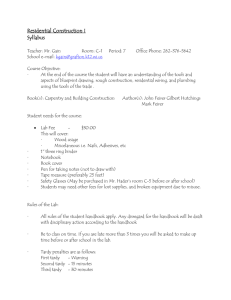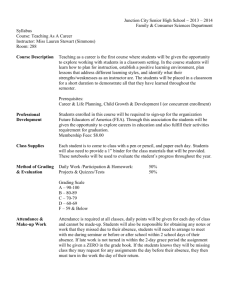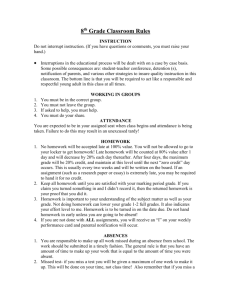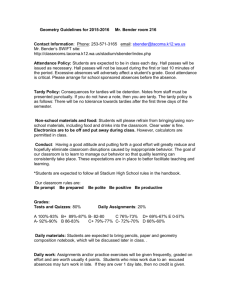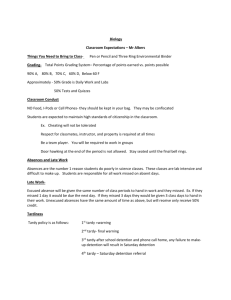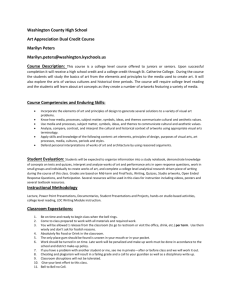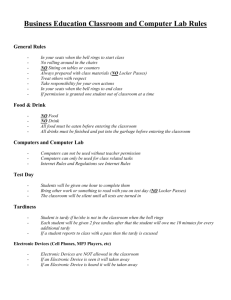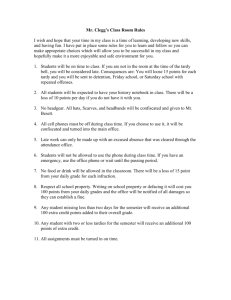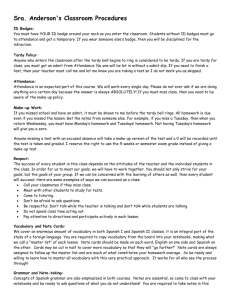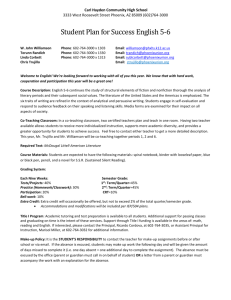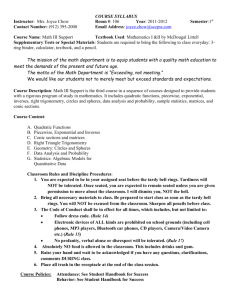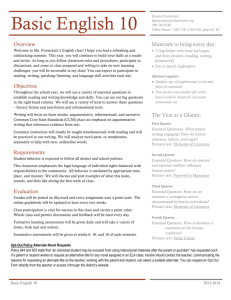College Math Syllabus 2015-2016
advertisement
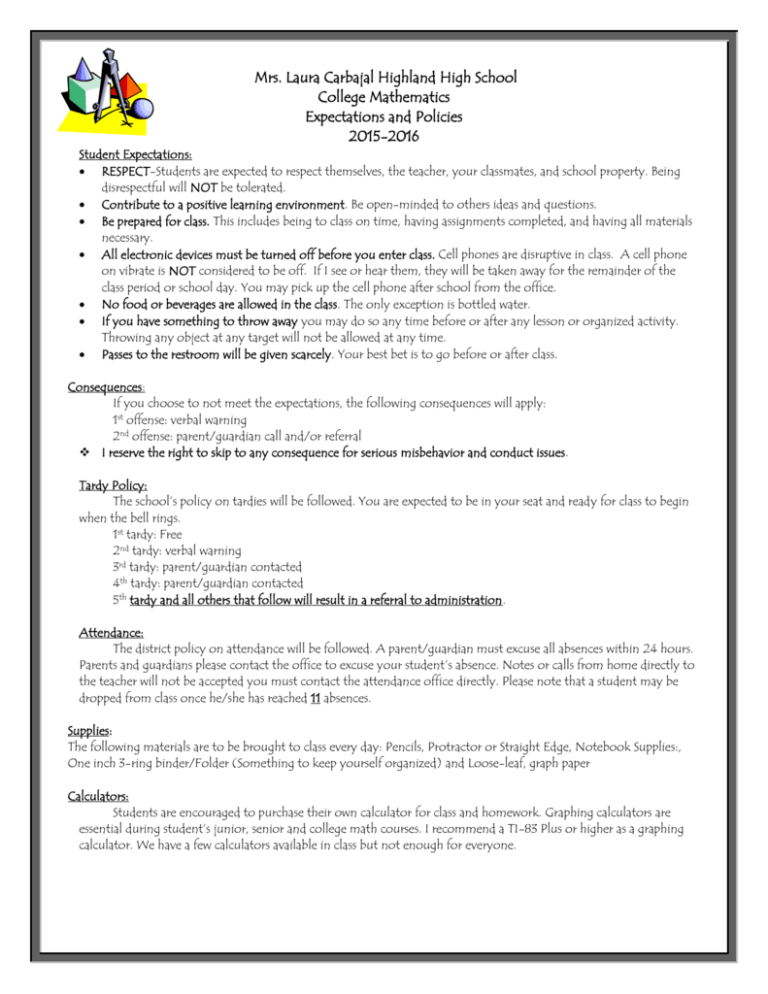
Mrs. Laura Carbajal Highland High School College Mathematics Expectations and Policies 2015-2016 Student Expectations: RESPECT-Students are expected to respect themselves, the teacher, your classmates, and school property. Being disrespectful will NOT be tolerated. Contribute to a positive learning environment. Be open-minded to others ideas and questions. Be prepared for class. This includes being to class on time, having assignments completed, and having all materials necessary. All electronic devices must be turned off before you enter class. Cell phones are disruptive in class. A cell phone on vibrate is NOT considered to be off. If I see or hear them, they will be taken away for the remainder of the class period or school day. You may pick up the cell phone after school from the office. No food or beverages are allowed in the class. The only exception is bottled water. If you have something to throw away you may do so any time before or after any lesson or organized activity. Throwing any object at any target will not be allowed at any time. Passes to the restroom will be given scarcely. Your best bet is to go before or after class. Consequences: If you choose to not meet the expectations, the following consequences will apply: 1st offense: verbal warning 2nd offense: parent/guardian call and/or referral I reserve the right to skip to any consequence for serious misbehavior and conduct issues. Tardy Policy: The school’s policy on tardies will be followed. You are expected to be in your seat and ready for class to begin when the bell rings. 1st tardy: Free 2nd tardy: verbal warning 3rd tardy: parent/guardian contacted 4th tardy: parent/guardian contacted 5th tardy and all others that follow will result in a referral to administration. Attendance: The district policy on attendance will be followed. A parent/guardian must excuse all absences within 24 hours. Parents and guardians please contact the office to excuse your student’s absence. Notes or calls from home directly to the teacher will not be accepted you must contact the attendance office directly. Please note that a student may be dropped from class once he/she has reached 11 absences. Supplies: The following materials are to be brought to class every day: Pencils, Protractor or Straight Edge, Notebook Supplies:, One inch 3-ring binder/Folder (Something to keep yourself organized) and Loose-leaf, graph paper Calculators: Students are encouraged to purchase their own calculator for class and homework. Graphing calculators are essential during student’s junior, senior and college math courses. I recommend a TI-83 Plus or higher as a graphing calculator. We have a few calculators available in class but not enough for everyone. Textbook: Students will be issued a textbook to be taken home. We will have a class set of textbook for your use during class. We will be using the textbook Using and Understanding Mathematics A Quantitative Reasoning approach 5 th edition. Bennet and Briggs. Make-Up Work: The school policy states that for every EXCUSED day you are absent, you have ONE day to make-up missed assignments, test, etc. It is your responsibility to find out what you missed during class and the assignment. If the absence is UNEXCUSED, no credit will be given for the missed assignment and/or test or quiz. There are no retakes on tests or quizzes. It is your responsibility to schedule a time to take a missed exam or quiz within the make-up time frame. Homework: In order to be successful in this class, homework must be completed in pencil daily. There will be time in class to discuss any problems you are having on the homework assignments. You will be assigned homework daily. In order to receive full credit for an assignment you must show all work. No late work will be accepted unless you have an excused absence. Homework will be check for completeness every day. I do collect random assignments for accuracy. Grades: Your semester grade is broken down by the following percentage. Homework: 15% Tests/Projects/Quizzes: 65% Final Exam: 20% The grading scale follows the standard grading scale of Gilbert Public Schools. A 100-90% B 89-80% C 79-70% D 69-60% F 59% and below I will not round up a grade that is if you have a 79.9% your grade is a C. Contact Information: Please feel free to contact me with any questions or concerns you may have. Email: Laura.Carbajal@gilbertschools.net Phone: 480-813-0051 EXT. 6192 Tutoring: I will be available most morning before and after school at 7:00am and after school 2:30pm, but let me know ahead of time in case I have a prior meeting. We do have tutoring for students during both lunches during 4 th hour in room 1273 and 5th hour in room 1274. If you are attending you tutoring during lunch make sure you come into hawk hall at the beginning of the hour. I look forward to a wonderful and exciting year! Sincerely, Ms. Laura Carbajal MCCCD Official Course Competencies: MAT 142-College Mathematics 1. Distinguish between a subset and a proper subset. (I) 2. Use Venn diagrams to solve applied problems involving the union, intersection, and complement of sets. (I) 3. Distinguish between experimental and theoretical probability, and use each to solve applied problems. (II) 4. Use conditional probability to solve applied problems involving dependent events. (II) 5. Use probabilities to calculate odds, either in favor of or against a particular event, and vice versa. (II) 6. Solve probability problems involving combinations and permutations. (II) 7. Organize, analyze, and display data using multiple representations. (III) 8. Calculate and interpret measures of central tendency and dispersion. (III) 9. Calculate and interpret measures of location (percentiles and quartiles). (III) 10. Solve applications using the normal distribution. (III) 11. Solve applications involving loans and amortizations. (IV) 12. Solve applications involving annuities. (IV) 13. Calculate the annual interest rate given the annual yield and vice versa. (IV) 14. Solve real-life problems using exponential growth. (IV) 15. Use appropriate formulas and units of measure for composite geometric shapes and figures from real life problems. (V) 16. Apply unit analysis skills to solve applied problems. (V) 17. Use dimensional analysis to convert units of measurement between different systems. (V) 18. Use written and verbal communication to describe process and results. (I-VI) 19. Model and solve real-world problems. (I-VI) MCCCD Official Course Outline: MAT142-College Mathematics I. Set Theory A. Venn diagrams B. Set operations II. Probability A Experimental vs. theoretical probability B. Conditional C. Odds D. Permutations and combinations III. Statistics A. Descriptive B. Normal distribution C. Percentiles and quartiles IV. Finance A. Annuities B. Simple vs. compound interest C. Exponential growth D. Loans E. Rates vs. Yield V. Geometry A. Perimeter/area/volume B. Unit conversions VI. Additional Topics-Departments may include one or more of the following topics in the course. A. Logic B. Numeration systems C. Inferential statistics D. Voting theory E. Math of music F. Index numbers G. Graph theory H. Geometry topics 1. Symmetry 2. Tessellations 3. Fractals
